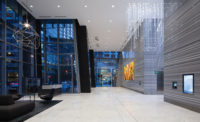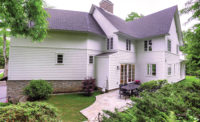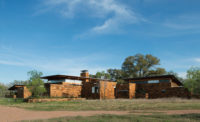For Greenburg, a posh apartment complex set on the backdrop of one of India’s lush golf courses in Gurugram, Haryanaa, sustainability and affordability were at the heart of the design. Local stone was preferred for the building’s exterior satisfying aesthetic, as well as, performance requirements.
“The main objective was to design homes that are uncompromised in any way,” explained Anushree Sharma, creative head at Design Forum International in New Delhi, India. “Greenburg’s resplendent aesthetics are a visible commitment to luxury and acres of artistic greenery in a residential context through the grassy golf course, the verdure manicured lawns and the refreshing water features. These luxury apartments are an amalgam of green and luxury.”
Sharma went on to explain another important concern of the design was to retain the existing trees on the site and prevent any harm to them during the various stages of construction, which took a total of three years to complete. “To ensure this, no basement was planned under the trees and ample precautions were taken to sustain these trees at the locations identified,” she said.
From the onset, the design team favored natural stone, as opposed to competitive building materials. “Natural stone holds an outstanding position among all building materials,” explained Sharma. “Components of natural stone are unique specimens that can be combined with each other and with any other materials. It is also ecological found in nature in already finished form. No energy is needed for its actual manufacturing. Energy is only consumed for quarrying and processing, but the share is small when compared to other building materials. It is also environmentally compatible, durable and it ages well unlike other stones.”
Each beautiful contemporary apartment within the complex features a variety of stone for various interior applications. A beige-colored stone floor flows from room to room providing a soft yet elegant look in the living space. In the kitchen, the stone floor is complemented by a granite countertop, and a stone vanity top is also stationed in the bedroom. For the bath, large-format floor tile was selected, as well as granite for the vanity top, bath surround and shower.
Outside, Gwalior stone was employed as cladding on the lower three floors, while regional red sandstone and Gwalior stone was used for landscaping around the complex. “Easy availability of the stone and the cost were factors that determined the stone selection,” said Sharma. “Stones that were available locally and suited the climate of the region were therefore given preference. It took around eight weeks of researching the appropriate types of stones to be used that suited the local climatic conditions and were easily available in the region.”
According to Sharma, the most challenging aspect of the project was the factor of cost against time. “Gwalior stone and red sandstone by themselves are not expensive stones and are readily available,” she said. “However, the cladding process is cost consuming and particularly for this type of stone, the dry cladding process is used, which further adds to the expenses.”
But even though slight obstacles were encountered, the end result was a success. “The project catered to the client brief of having a green and sustainable housing under a given budget, which didn’t compromise on any of the facilities while being luxurious and unique in every sense,” said Sharma. “Achieving the design intent and fulfilling the brief, while accommodating the contextual concerns through materiality, the clients were satisfied and happy with the project.”








